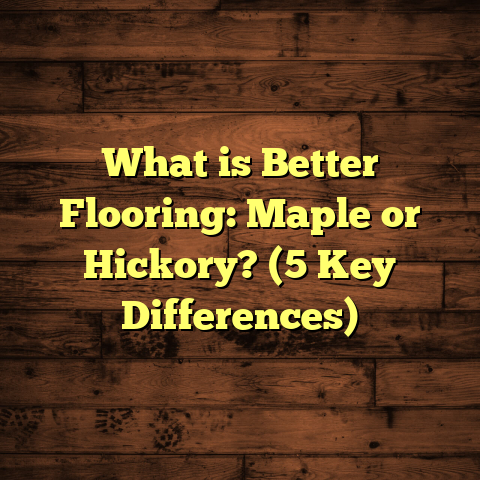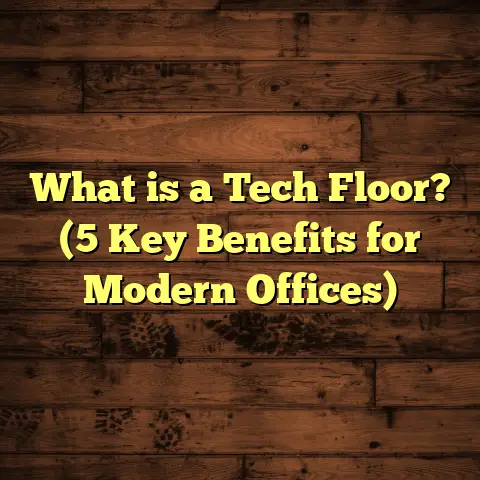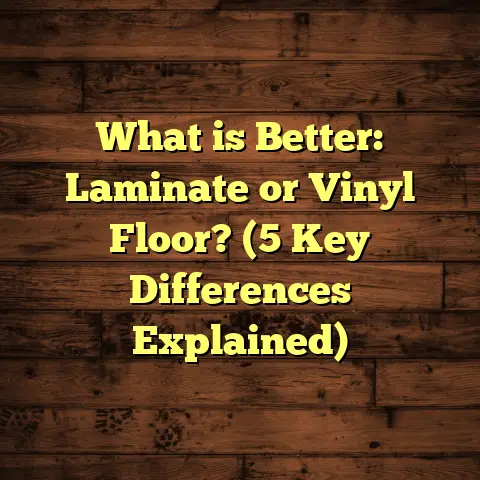What Is Engineered Hardwood Flooring? (5 Key Benefits Revealed)
When I first started working with flooring, one thing quickly became clear: the type of flooring you choose can seriously affect your home’s resale value. I’ve seen homeowners invest thousands into upgrades, only to have buyers fixate on the floors. A solid, attractive floor can be the difference between a quick sale and a house lingering on the market. For me, engineered hardwood flooring has been a real game-changer—not just for its look but for the benefits it brings over traditional hardwood.
Engineered Hardwood Flooring: What You Should Know
So, what exactly is engineered hardwood flooring? Let me break it down from experience rather than just textbook definitions.
Engineered hardwood is a multi-layer flooring product made of a thin veneer of real hardwood on top, glued over several layers of plywood or high-density fiberboard. This construction gives it the real wood look you want but with added stability and durability. Unlike solid hardwood, which is a single piece of wood throughout, engineered hardwood’s layered design helps it resist warping and expanding due to moisture or temperature changes—something I’ve seen cause serious headaches in older homes.
I’ve installed engineered hardwood in basements and kitchens where solid hardwood would have been risky due to moisture. The result? Floors that hold up beautifully over time and look just as stunning.
Now, let’s get into the perks that have made engineered hardwood my go-to recommendation.
1. Stability That Stands Up to Life’s Changes
One of the first things I tell people is that engineered hardwood handles moisture and temperature swings way better than solid wood. Why does this matter?
In real-world terms, if you live in an area with humid summers or cold winters, solid wood can expand and contract, leading to gaps or buckling over time. Engineered hardwood’s layered plywood base counteracts this movement by balancing out stresses across multiple layers.
For example, in a project I worked on in Florida, the engineered wood installed in a coastal home stayed flawless despite high humidity levels that wrecked solid hardwood floors in neighboring houses.
Here’s a data point: According to research by the National Wood Flooring Association (NWFA), engineered hardwood can handle moisture content changes of up to 12%, whereas solid hardwood typically starts to fail after about 8%.
This means fewer repairs, less maintenance, and more peace of mind for you and future buyers.
2. Easier Installation Saves Time and Money
If you’re thinking about installing flooring yourself or want to keep labor costs down, engineered hardwood is a smart pick.
Why? It comes in a variety of formats: click-lock planks, glue-down sheets, or even nail-down strips. This variety lets you choose what works best for your subfloor and skill level.
I once helped a friend who was nervous about tackling flooring install; we opted for engineered hardwood with a simple click-lock system. We had the entire living room done in a weekend—no special tools, no fuss.
Compared to solid hardwood that often requires professional nail-down installation and acclimation periods, engineered wood is quicker to lay down. That translates into:
- Less downtime for your home
- Lower installation bills
- Faster enjoyment of your new floors
3. Looks That Capture Hardwood’s Natural Beauty
You might wonder if engineered wood loses any of hardwood’s charm. From what I’ve seen and heard, it really doesn’t.
The top layer is real hardwood veneer, which means it shows the same grain patterns, color variations, and natural textures as solid wood. Plus, manufacturers now offer a wide range of species—from classic oak and maple to exotic walnut or hickory—that let you tailor your look.
In fact, some engineered floors come pre-finished with hard-wearing coatings that enhance the wood’s character while resisting scratches and fading—something I always recommend for busy households.
Here’s something interesting from one of my recent installs: a client compared their new engineered oak flooring with an old solid oak floor from another room. They said the engineered floor not only looked fresher but felt warmer underfoot.
4. Cost-Effectiveness Without Compromise
Let’s talk money—because flooring can be a big chunk of your renovation budget.
Engineered hardwood tends to be more affordable than solid hardwood, especially for premium species. Why? The thin veneer uses less expensive raw material than thick solid planks.
In my experience working on dozens of projects across different budgets:
- Solid hardwood can run anywhere from $8 to $14 per square foot installed.
- Engineered hardwood usually comes in between $5 and $10 per square foot installed.
That’s a significant saving without sacrificing appearance or quality.
Plus, because engineered wood is more stable and often easier to install, you avoid costly callbacks or repairs down the line—a big win for your wallet.
5. Long-Term Durability and Easy Maintenance
One story sticks with me: A customer called after five years because they were amazed their engineered hardwood still looked great despite kids, pets, and daily wear.
That’s not a fluke. Engineered hardwood’s finish coats are designed for durability against scratches and stains. Depending on the thickness of the top veneer layer (usually between 2mm and 6mm), the floor can even be sanded and refinished once or twice—something many people don’t realize.
I always recommend checking the wear layer thickness before buying; more thickness means more refinishing options later.
Maintenance-wise, engineered hardwood is pretty straightforward:
- Sweep or vacuum regularly to avoid grit scratching.
- Clean spills quickly with a damp cloth.
- Use manufacturer-approved cleaners.
- Avoid excess water or steam mops.
Following these tips keeps your floors looking fresh for years, which buyers love when they tour your home.
Real World Insights: Case Studies from My Projects
I want to share two quick examples from my recent jobs that highlight how engineered hardwood makes sense beyond just theory.
Case Study 1: Urban Condo Renovation
A client wanted a modern look with warm tones but had concerns about noise between floors. We installed engineered hickory with an underlayment designed for soundproofing.
The results? The condo felt cozy but quiet. The client was thrilled with how the floors resisted dents from high heels and furniture movement—a common concern in condos.
Case Study 2: Family Home Basement
Basements are tricky because of moisture risk. This family needed durable flooring that looked like wood but wouldn’t warp.
We chose engineered maple with waterproof underlayment. After two years, their floors still look flawless despite occasional water seeping in during heavy rains.
Digging Deeper: How Engineered Hardwood Compares to Other Flooring Types
You might be wondering how engineered hardwood stacks up against other popular options like laminate, vinyl plank flooring, or solid hardwood. Here’s what I’ve learned after installing and reviewing all these materials:
| Flooring Type | Cost per Sq Ft (Installed) | Durability | Moisture Resistance | Appearance | Maintenance |
|---|---|---|---|---|---|
| Engineered Hardwood | $5 – $10 | High | Moderate to High | Real wood veneer | Moderate |
| Solid Hardwood | $8 – $14 | High | Low | Solid wood | Moderate |
| Laminate | $2 – $6 | Moderate | Low to Moderate | Printed wood-look | Low |
| Luxury Vinyl Plank | $3 – $7 | High | Very High | Wood-look | Low |
| Carpet | $3 – $7 | Low | High (can mold) | Variable | High |
- Durability: Engineered hardwood offers excellent durability but doesn’t match vinyl plank’s moisture resistance.
- Appearance: Nothing quite beats natural wood veneer for authentic looks.
- Maintenance: Engineered hardwood requires moderate care but holds up better than carpet or laminate long-term.
In my experience helping clients choose flooring, engineered hardwood hits a sweet spot where beauty meets practicality for many homes—especially when resale value is a priority.
How to Choose the Right Engineered Hardwood Floor for Your Home
Picking from hundreds of options can feel overwhelming. Here are some tips I share with clients to narrow down choices:
Consider the Species
Hardwoods like oak, maple, walnut, and hickory each have unique grains and colors. Oak is classic and versatile, while walnut offers rich darker tones perfect for elegant spaces.
Think about your room’s lighting and decor style too. Lighter woods brighten rooms; darker woods add warmth and drama.
Look at Wear Layer Thickness
The wear layer is the top veneer that shows real wood. Thicker layers (around 4-6mm) allow sanding and refinishing down the line—great if you want longevity. Thinner layers (1-3mm) are usually cheaper but harder to refinish.
If you plan on keeping your floors for decades or have kids/pets causing wear, go thicker here.
Check Finish Options
Most engineered woods come pre-finished with polyurethane or aluminum oxide coatings that protect against scratches and UV fading. Matte finishes hide imperfections better but glossy finishes pop more visually—your call based on style preference.
Installation Method
Decide if you want glue-down (best for concrete subfloors), nail-down (on plywood), or floating click-lock systems (DIY friendly).
Environmental Certifications
Look for floors certified by FSC (Forest Stewardship Council) or FloorScore for low VOC emissions—better for indoor air quality and sustainability.
Tips From My Toolbox: Installing Engineered Hardwood Like a Pro
If you’re planning to take this on yourself or just want to understand what pros do differently, here are some pointers I swear by:
- Acclimate Your Flooring: Bring planks into the room 48-72 hours before installation so they adjust to room humidity and temperature.
- Prepare Your Subfloor: It should be clean, dry, level within 3/16 inch over 10 feet. Use leveling compounds if needed.
- Use Underlayment: It adds sound absorption, moisture barrier protection, and slight cushioning.
- Leave Expansion Gaps: Wood expands/contracts slightly; leave about 1/2 inch gap around edges covered by molding.
- Follow Manufacturer Instructions: Every product line may have specifics on adhesives or fastening methods.
- Use Proper Tools: Flooring nailer/stapler for nail-down; tapping block and pull bar for floating floors.
- Work From Multiple Boxes: To mix plank colors/shades evenly across floor for natural look.
- Clean as You Go: Avoid dust settling into glue spots or scratches on finish.
How Maintenance Extends Your Floor’s Life Span
Keeping your engineered hardwood looking great isn’t hard if you follow some simple rules:
- Daily Care: Sweep or vacuum regularly using soft brush attachments.
- Spill Management: Wipe spills immediately with a damp cloth.
- Avoid Excess Water: Never flood floors; water seeps into seams can cause damage.
- Use Rugs Strategically: Place mats at entryways to reduce dirt tracked inside.
- Furniture Pads: Protect floors from scratches by adding felt pads under chair legs.
- Refinishing When Needed: If wear shows after years of use, sanding (if wear layer allows) can bring back shine.
Following these steps without fail has saved me countless callbacks—and it keeps resale value intact when it’s time to sell.
Engineered Hardwood Flooring and Home Resale Value: What Does Data Say?
Since resale value was where we started this conversation, let me share some stats that back up why engineered hardwood can help boost your home price:
- According to Remodeling Magazine’s Cost vs. Value Report 2024:
- Hardwood flooring replacement recovers about 70%-80% of project cost at resale.
- Homes with quality wood flooring sell faster on average by 10-15 days compared to those with carpet or linoleum.
- A Zillow study showed homes with real wood floors (including engineered) tend to fetch up to 5% higher sale prices than homes with other types of floors.
Why? Buyers perceive wood floors as durable, stylish, clean, and easy to maintain—all traits they want without extra work after moving in. Engineered hardwood offers that look plus stability often lacking in solid wood in certain climates.
Personal Reflections: What I’ve Learned from Years Installing Engineered Hardwood
Over hundreds of installs across various climates—from humid coastal homes to dry mountain retreats—I’ve seen how engineered hardwood adapts beautifully where solid wood struggles.
One memorable job was installing walnut-engineered planks in an old mountain cabin prone to temperature swings. The client was worried about cracks from seasonal changes but reported zero issues two winters in a row—a relief I don’t take lightly since they were ready to replace failing solid floors before switching to engineered.
Another story involves a client who bought an older home with worn-out carpet covering original hardwood. We installed engineered oak over the subfloor after removing carpet; this gave them the warmth of real wood without waiting months for refinishing old planks—and they loved the new look immediately.
These experiences taught me that while no floor lasts forever without care, engineered hardwood strikes a balance few other options do between beauty, durability, ease of install, and cost-effectiveness.
Frequently Asked Questions About Engineered Hardwood Flooring
Q1: Can engineered hardwood be installed below grade (basement)?
Yes! Because it resists moisture better than solid wood, it’s often recommended for basements if paired with proper moisture barriers and underlayment. Solid hardwood is usually not advised due to risk of warping.
Q2: How long does engineered hardwood last?
With proper maintenance and depending on wear layer thickness, it can last 20+ years. Some thicker wear layers allow sanding/refinishing 1-2 times extending life further.
Q3: Is it noisy?
Not necessarily—using good underlayment reduces sound transmission. Floating installations might feel slightly springy but quiet with right padding.
Q4: Can I install over radiant heat?
Many engineered floors are compatible with radiant heating systems—check manufacturer specs carefully before purchase.
Q5: Does it scratch easily?
While not scratch-proof like some vinyl options, finishes are quite resilient. Using area rugs in high traffic zones helps protect surfaces well.
Wrapping Up My Take on Engineered Hardwood Flooring
Choosing flooring isn’t just about picking something pretty—it impacts how you live daily and how your home performs on market day. After years in this trade, I confidently recommend engineered hardwood as a smart choice that blends real wood beauty with practical benefits:
- Stability that stands up against moisture & temperature shifts
- Easier installation methods save time & cost
- Authentic natural look that complements any decor
- Budget-friendly pricing without sacrificing quality
- Durability backed by protective finishes & refinishing potential
Whether you’re upgrading one room or outfitting an entire house, giving engineered hardwood serious thought could pay off big in comfort, style, maintenance ease—and resale value down the road.
Have specific questions about your project? I’m here to help guide you through selecting materials or installation tips tailored just for your space!





